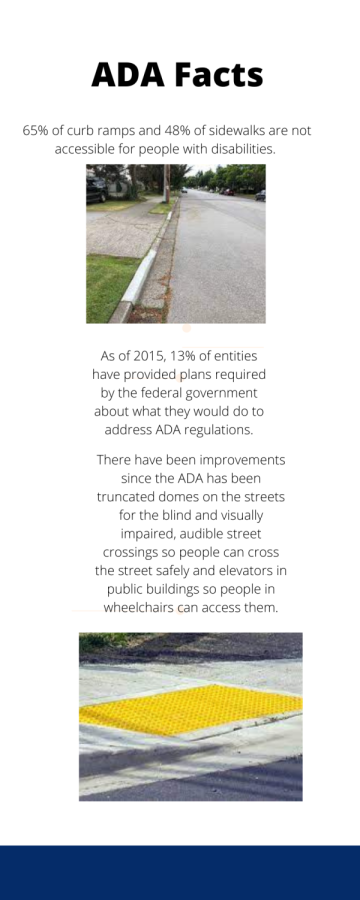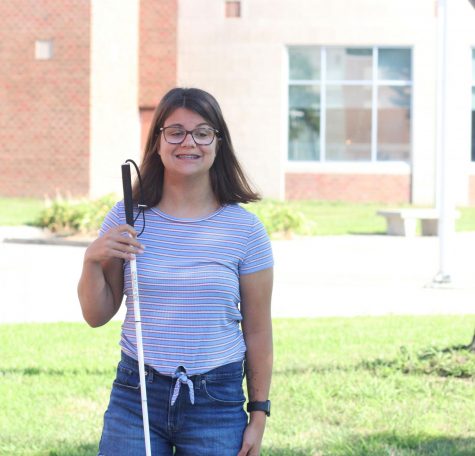Accessibility for all
The Americans with Disabilities Act needs to change laws in order to make people’s lives easier
Infographic by Camille O’Neill
This is an infographic I made with facts and pictures pertaining to the ADA. The ADA is in its 32nd year as a law.
April 14, 2022
The Americans with Disabilities Act (ADA) was passed by Congress in 1990 in hopes of making the lives of people with disabilities better. Some of the improvements that have been made include adding truncated domes by streets in order to make street crossings more accessible for people who are blind and visually impaired and making sure there are curb cuts so people in wheelchairs can cross the street safely. The act also ensures that people with disabilities can participate in civic life in general.
It is up to the city and state governments to ensure that local programs comply with the ADA, and oftentimes, cities do not do enough to make public life accessible for all. According to ADA.gov, many small cities aren’t compliant because they think they don’t have to because of their size. While companies with less than 50 employees don’t have to go through the self-evaluation process, they still need to comply with Title II of the ADA prohibiting discrimination based on disability in public paces. There needs to be better enforcement of ADA laws both at the federal and state levels.
The federal government requires city and state governments to have written plans in place in order to improve accessibility in their local area. As of 2015, only 13% of cities had these action plans readily available. The federal government needs to make sure that more cities comply with the regulations by better enforcing the laws. In 2015, the federal government created a special committee to try to enforce the ADA laws, which has caused the number of cities that comply to go up slowly. The state of Nebraska struggles with providing accessibility for all on many levels.
As a person living with multiple disabilities, I’ve experienced barriers in trying to access places in the city of Omaha. In January 2019, after I had a major surgery, I was attempting to walk into a building using my walker and realized that there was no curb cut to get my walker straight up into the building. I had to figure out a way around this situation by lifting up the front of my walker onto the curb, stepping up and then lifting the back part of my walker up. This was very difficult, especially in the middle of winter. Because of this experience, I think the act should be revised so that all buildings should be accessible to people in wheelchairs and walkers can access the buildings safely.
I’ve also found that there are accessibility issues in most arenas and stadiums that host sporting events. While there are plenty of elevators and seating for people in wheelchairs, the rest of the seating isn’t accessible to people who have moderate mobility issues like I do. It would be more difficult for a person with no or low vision to access high stadium seats because of the breaks in the railings and the risk of falling. While I get that the breaks in the railings are there in case people need to cross over to the other side of the railing, the risk is just too high. Stadiums need to make changes to ensure that everyone can attend sporting events they enjoy.
Not only should the ADA apply to public spaces, but it should also apply to private spaces, such as housing. In 1988, Congress passed the Fair Housing Act to include people with disabilities as a group that can’t be discriminated against. Despite this provision, less than 2% of houses are accessible to people with moderate mobility issues, and the fraction is even lower for people in wheelchairs. The law needs to be amended so that the Fair Housing Act includes single-family homes as well as duplexes. There also needs to be something in the housing code that requires it to be accessible for everyone.
I’ve been to many unfamiliar houses where I’ve had issues navigating because of the way the house is laid out. For example, a house that I visit very often has a railing that only goes halfway up the steps. This could cause people with moderate mobility issues to slip, fall or get hurt.
Another issue I’ve noticed, particularly in Omaha, is the lack of public transportation access. Although Omaha does have a bus system, it’s unreliable, especially for people who live in west Omaha. The city needs to expand their bus system so that there are consistent stops all the way across town. Although there are other ways to get around such as Uber, ridesharing apps can be expensive and costs can quickly add up.
Clearly, states needs to better enforce ADA laws so that people of all abilities have access to public spaces, as well as private spaces. A lot has changed since 1990, and those laws need to reflect this.







